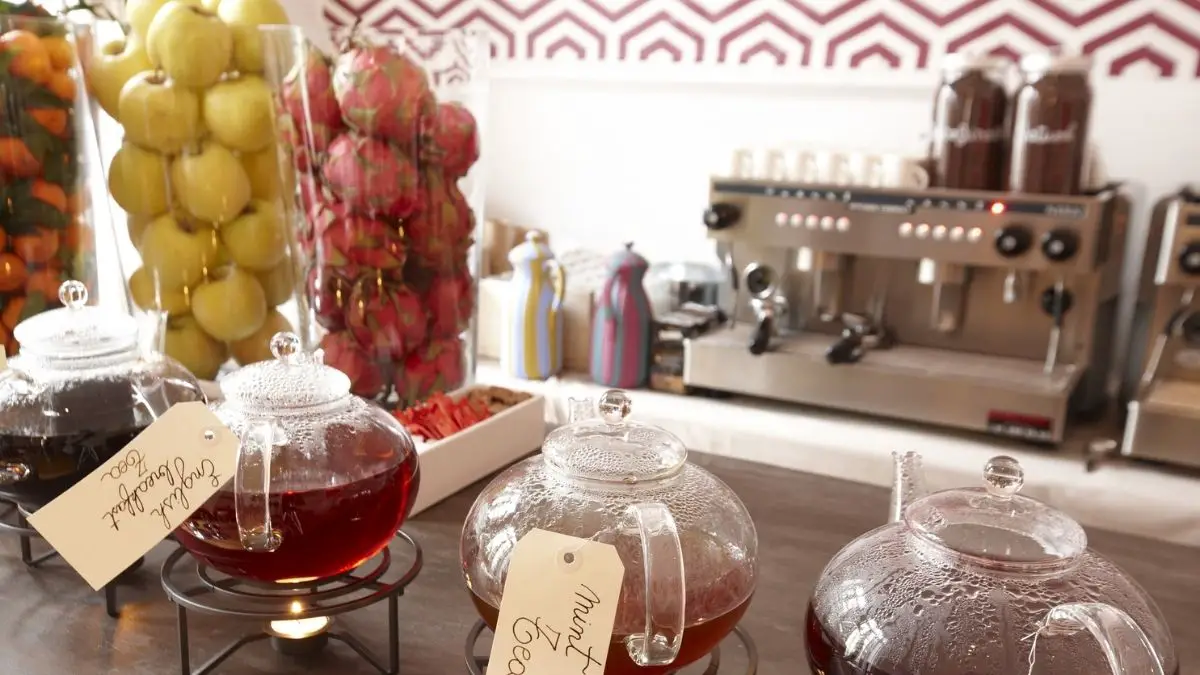Many coffee enthusiasts have been curious about trying to make their tea and sipping the slightly caffeinated, herbal blend once in a while instead of coffee. As you may have heard, tea can be brewed and served via drip, pour, French press, and perhaps any coffee-brewing method palatable to the consumer. However, have you ever heard of tea coming through an espresso machine?
An espresso machine comes with a portafilter that has incredibly tiny holes on a metal basket that only allows liquids and minute molecules to pass through under immense pressure. Yes, you can put your tea in a portafilter and brew it as you would with an espresso shot, but there are a few things you need to consider.
Factually enough, an espresso machine isn’t designed to extract tea, and though the process is possible, the result may not immediately meet your expectations. Making tea is fundamentally different from making coffee. So other formulas should be considered and done in tea making that may not be the same as with coffee making.
Therefore, what we’ll discuss here is a summary of the comparison between tea and coffee making, and how we could apply these notes to make a wonderful tea right from an automatic espresso machine.
Tea And Coffee: A Comparison
Origin
Tea is made from the special green leaves of the Camellia sinensis or tea plant, while coffee is made from the dried beans of various species of coffee plants. Since tea comes from leaves and coffee comes from seeds of the fruit, they are bound by different processing and preparation methods.
In a blog from the Sencha Tea Bar, they discuss the beginning of tea preparation and how all variants of tea: green, white, black, oolong, and pu-erh, come from the same tea plant. These teas are called true teas as some of those herbal infusions that you would find in the grocery don’t contain leaves from the real Camellia sinensis.
Like the coffee plant, the tea plant is commonly raised in high elevations where they develop complex and potent flavors that people enjoy. So both plants raised at higher elevations are considered to be better in quality compared to those raised in low-level areas. This superior development plus the additional difficulty of raising high-elevation plants results in eye-gauging prices. However, the notable taste and aroma emanating from the products are very much worth it.
Both plants also prefer acidic soil and subtropical to a tropical environment where rainfall and precipitation are abundant. Their shrubs can grow very tall over the years but they are usually kept below or near-human height to maximize production and also make it easier for the workers to hand-pluck the produce.
After harvesting, the tea leaves are sorted into five main categories: green, white, black, oolong, and pu-erh. Leaves that are broken or damaged by sun and water are discarded so that only the best leaves remain. This overly strict picking method would allow a meager fourth of every 100 kg of tea leaves to advance to the next production step.
While picking coffee cherries follows the same process, the best are immediately selected while the rest are left to ripen. Coffee cherries also aren’t sorted into different types, as, unlike the tea plant, all the fruits are processed into a single, uniform blend.
However, just like the strict method of harvesting the best tea leaves, in every 100 or 200 pounds of coffee cherries, only about a fifth would produce actual, great-tasting coffee beans.
Also note that the Robusta variant is grown in low elevations, resulting in bland or bitter coffee that has less acidity and more caffeine than the average Arabica blend. Robusta is also less expensive than Arabica because it costs less labor. Robusta is commonly harvested via stripping or shaking. Stripping is when all the cherries are stripped off the branches regardless of ripeness while shaking uses a special machine that shakes the plant and causes all of its cherries to fall off.
Preparation
Simply put, the five main variants of tea are produced via the different stages of harvested leaves. White tea is immediately produced by hand rolling and drying the fresh leaves under the sun. Green tea comes when these hand-rolled leaves are further dried via pan-firing or steaming over and over again. Matcha comes from the highest quality green tea leaves ground into powder.
Furthermore, oolong and black teas are subjected to withering to reduce the moisture of the leaves and prevent them from flaking during the machine rolling process. This rolling method isn’t just about shaping the leaves, but they also break down their internal cell structures that contain the essential oils. These oils react with oxygen via oxidation which then allows the dried leaves to develop their distinctive and pleasurable taste and aromas.
This then begins the fermentation process where enzymes and oxygen break down chlorophyll (what gives leaves their colors) and create tannins that cause the leaves to turn darker. Oolong tea is semi-oxidized, in which it only spent a bit of time fermenting before it’s subjected to absolute drying (pan-firing, sun-drying, or baking). Black tea is completely oxidized which is why it appears darker and presents bolder, robust flavors.
Finally, pu-erh tea is made with leaves oxidized and post-fermented for years. Like wine, this tea tastes better and better the longer they age. This is what makes pu-erh tea the most expensive and unheard of because it’s that rare and refined.
Teas in infusion bags are ripped and torn leaves that differentiate only from how it’s rolled. Instead of standard rolling, the leaves are rolled with teethed machines that crush them into tiny bits.
Despite all the methodological variations, steeping is the key to making your tea. Steeping times vary on tea type and the kind of pot or specialized bowl you’re using, even the shape of the tea matters as shredded leaves usually steep faster given the greater particle surface area and exposure. Temperature also counts but is not as important as with coffee, since tea leaves are in a state of releasing their flavor compounds and simply immersing them underwater long enough would easily disperse those.
Coffee on the other hand, regardless of variant, is processed the same most of the time, with the only exception of those with special preparations such as Golden Ratio’s Gold Roasted Low-Acid Coffee.
Referenced from the National Coffee Association, the coffee beans are dried, hulled, polished, sorted according to size and quality, and taste-tested before fully roasting them to become light-, medium-, or dark-roast coffee. Then they are ground to a preferred size before finally brewing to serve.
Tea And Espresso Machine
As you all have heard, medium to dark roast blends are preferred for espresso, this is because they have the right amount of acidity, sweetness, and boldness to pull a great-tasting shot. However, more than just the roast and fine grind size, the brewing and extraction time matters a lot in espresso making.
As I’ve said before, steeping in water is the key factor in making luscious tea, and so for as long as the tea leaves are in direct contact with water, the more flavor-inducing amino acids, polyphenols, and essential oils are introduced. Unlike espresso which only takes 30 seconds to brew, tea is brewed at an average of 3 minutes. So your first pull of tea may result in a bland or extremely bitter drink.
So, how shall we fix this?
Use Darker Tea Leaves
Like coffee beans, the darker your tea leaves are, the bolder flavors they will contain. Unlike fresh green tea, oolong and black tea contain essential oils that add a stronger taste and aroma to your cup. These oils don’t completely dissolve in the water though, but rather they are emulsified in which particles of oils are trapped within molecules of water and gas, while some of the oils float on top, creating a soothing surface and introductory fragrance.
Also thanks to the portafilter, these oils seep through the brew a lot better than using a paper-filtered method that holds in the oils.
Use Fine Ground Size
Whole or partially shredded tea leaves won’t sit well in your portafilter, which is why you should grind them to powder consistency so that you can properly press them tightly into the porous basket. This allows for a smoother and more flavorful extraction because more surface area per particle of tea is exposed to the water, so more taste polyphenols are saturated and dissolved into the liquid.
Watch out for grinding too fine though, as if the leaves are too powdery, the bitter compounds may take over, so a good guide would be to grind them as fine as you would with you’re espresso blend.
Use Warmer Water
Typically, tea leaves steep well enough at temperatures within 100° F, the standard extraction temperature of espresso at 200° F is simply too much and would end up leaving a burnt taste in your tea. So it’s best to adjust the water temperature in your espresso machine before extracting your tea.
You don’t have to worry too much if you’re using black tea though, as the leaves are well-accustomed to heat and can tolerate smoldering temperatures like coffee brews. Make sure to clean your portafilter right after brewing your tea or coffee to prevent recurring and mixed tastes.
Bottom Line
You can pretty much brew tea in any way, just like coffee, but I highly discourage you from using drip or pour-over methods as these don’t bring the tea to its fullest potential.
There’s just as much fun in brewing and making tea as is with coffee, and both of them have real health benefits. I hope you do enjoy whatever beverage you prefer, it’s all about being creative and adventurous to discover new possibilities that you never thought of before.

